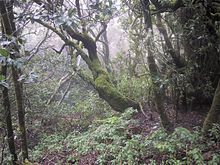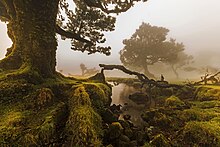Laurisilva
The laurel (also Latin laurel , German laurel forest ) is on the Spanish Canary Islands of La Gomera , La Palma , Gran Canaria , El Hierro and Tenerife and the Portuguese islands of Madeira and Azores common evergreen and always moist forest type of the elevation level of the mountain range between 500 and 1,400 meters above sea level and is therefore in the subtropical cloud forest level .
The Laurisilva is a regional expression of the plant formation of the laurel forest that is widespread worldwide . This means that forests of a similar shape also exist elsewhere under similar climatic conditions, but they are composed differently in terms of floristic details , in particular from other tree species.
Before humans arrive on the islands, the Laurisilva - according to bioclimatic and local reconstructions - is said to have been about 200,000 hectares in the Azores, about 105,000 hectares in the Canary Islands and 60,000 hectares in Madeira; that is, around 365,000 hectares in all of Macaronesia. There are currently around 40,000 hectares, with a focus on Madeira and Gomera. That is about 12.5 percent of the original area. The Laurisilva is used for forestry purposes, only small stands in remote locations are still primeval forests.
natural reserve
The Garajonay National Park on La Gomera (the largest contiguous laurel forest in Europe) and the Laurisilva laurel forest of Madeira are both UNESCO World Heritage Sites . As a priority protected habitat type 9360, within the framework of the Habitats Directive of the European Union , almost all of the Laurisilva stands are part of the Natura 2000 network of protected areas . The European Union has issued instructions for their maintenance and management, which should form the basis of the management plans to be drawn up by the national authorities for the individual forest areas. 7 areas with a total of 3,665 hectares are protected on the Azores, one area (Parque Natural da Madeira) with 12,687 hectares on Madeira, 53 areas in the Canary Islands with a total of 6,612 hectares.
Features and locations
The Macaronesian laurel forest called Laurisilva is a humid (to hyper-humid), evergreen forest of the cloud forest level of the volcanic island mountains. When undisturbed, it can grow to a maximum height of around 40 meters and has a closed canopy. Under unfavorable site conditions, on drier locations or on steep rocky slopes, it changes into Macaronesian rock heaths, which are also a protected habitat type with numerous endemic species. It grows from about 500 to 1500 meters above sea level, mostly in northeast exposure, the prevailing wind direction of the trade winds , which provide it with moisture; Due to the different location and thus the wind direction in the Azores, it only prefers a south-westerly exposure here and occurs, or at least used to occur, almost at sea level. The average annual temperature is around 13 to 19 ° C, frost never occurs. The annual precipitation from rain reaches 500 to 1500 mm (under hyper-humid conditions in the Azores up to 3800 mm), in addition there are substantial amounts of water from the frequent fog, so that the forest almost never suffers from water stress.
While this plant community disappeared in Europe through the Ice Ages , and in the Mediterranean area only during the last Ice Age, it was able to partially survive on the Macaronesian Islands ( Canary Islands , Madeira and Azores ).
geography
The Garajonay National Park, located in the middle of La Gomera, covers around 10 percent of the island's area. Its ecosystem has been a UNESCO World Heritage Site since 1986 . The forests in the park are laurel forests that still exist here due to the absence of the Ice Age. The heart of the national park consists of an evergreen cloud forest with ferns up to two meters high, long beard lichens hanging from the trees, moss-covered gnarled branches and streams with a few waterfalls.
The laurel forest Laurisilva from Madeira on Madeira still covers around 20 percent of the island's area and thus has an area of around 150 square kilometers . They can be found on the north side of the island at an altitude between 300 and 1300 meters above sea level and on the south side between 700 and 1200 meters. Its ecosystem has been a UNESCO World Heritage Site since December 2nd, 1999 .
Flora and vegetation
Stock formative and namesake in the laurel forest are the four laurel species Azores laurel ( Laurus azorica , incl. Taxonomically controversial Laurus novocanariensis ) Barbusano ( Apollonias barbujana ), Persea indica or Madeira mahogany ( Persea indica ) and Stinklorbeer ( Ocotea foetens ). All four species are endemic to Macaronesia (although the Azores laurel has a tiny distribution area in the adjacent north-west Africa). The other tree species in the laurel forest also have widely similar leaf shapes (they are “laurel-leaved” or laurophyll ), including Portuguese cherry laurel ( Prunus lusitanica subsp. Hixa ), Picconia excelsa , Ilex canariensis and Ilex perado subsp. platyphylla , Pleiomeris canariensis and Heberdenia excelsa . The forests are often very rich in tree species and can contain more than 20 tree species on just a few hectares.
The laurel forests of the Azores have been massively overprinted by a neophyte, the Australian sticky seed tree ( Pittosporum undulatum ), which has become overgrown from culture and which has spread widely and displaced the native species.
In the shelter, in gaps and in transition stands to the rocky heaths, there is a rich layer of shrubbery or a second layer of trees made of wood species that remain lower; it includes species such as tree heather ( Erica arborea ); Madeira heather ( Erica scoparia ssp. maderensis ); the Madeira blueberry ( Vaccinium maderense ), the cedar juniper ( Juniperus cedrus ). The gale tree ( Myrica faya ) is also an endemic species of Macaronesia; like the tree-shaped heaths, it has its main distribution in the rocky heaths, but also occurs in the laurel forest. It was introduced to Hawaii by Portuguese emigrants towards the end of the 19th century and has proven to be a problematic neophyte that has a negative impact on the local biodiversity .
More than 40 endemic species live in the undergrowth of the laurel forest, as well as many representatives with small occurrences in special locations in the western Mediterranean area. Among the many species of fern is the radicans Kettenfarn ( Woodwardia radicans ) while with fronds of a length of up to two meters, the largest species. Among the flowering plants of the herbaceous layer of the laurel forest includes numerous endemic species, including striking as the Canary bellflower Canarina canariensis or ixanthus ( Ixanthus viscosus ).
In the plant-sociological system, the laurel forests of Madeira and the Canary Islands are included in the class Pruno lusitanicae-Lauretea azoricae , which is restricted to the islands . The actual forests form the order Pruno-Lauretalia azoricae. The laurel forests of the Canary Islands and Madeira most stocks are in a federation passed Ixantho viscosae-Laurion azoricae (in the same structure, which is the view in Natura 2000 based on the name is used only for the Canarian forests). The laurel forests of the Azores form a separate class Lauro azoricae-Juniperetea brevifoliae (designated in Natura 2000 as the order Ericetalia azorica).
fauna
The fauna of the Laurisilva also has endemic species. The three types of pigeons are particularly characteristic: the laurel dove ( Columba junoniae ) and Bolles laurel dove ( Columba bollii ) in the Canaries and the silver- necked dove ( Columba trocaz ) in Madeira. The highly endangered Azores bullfinch ( Pyrrhula murina ) is native to the Laurisilva of the Azores .
Tertiary relic hypothesis
Laurel forests as in the Canary Islands also existed in the Tertiary , according to a polar theory, in the Mediterranean region (southern Spain and North Africa), where they became extinct a few million years ago and gave way to the hard deciduous forests typical of winter rain areas. Indications for this are species such as real bay laurel , Portuguese cherry laurel or rooting chain fern, which are still found in the Mediterranean area today, sometimes only in tiny relic occurrences with particular humidity. The so-called "palaeotropic geoflora" of Europe had more in common with that of America than with that of East Asia. It disappeared from Europe in the wake of the increasingly colder and drier climates that peaked with the Ice Age.
A detailed examination of the areas of numerous Macaronesian species only partially supports this thesis: the flora of the islands includes, in addition to Mediterranean elements, also species originating in the tropics and subtropics (partly from America) and is generally rather young at approx. 3 million years ago, so only goes back to the Pliocene . However, it confirms the relic character of some species, of others, through fossil finds from the Mediterranean region, partly as far as Central Europe, a much larger area can be opened up than today. Both the geological age of the islands and numerous fossil finds make the relic character of the Laurisilva appear plausible overall. Today's forests would therefore resemble the former forests further north in their ecology and shape, which fell victim to the deterioration in the climate, but are probably only a remnant of them, which are severely impoverished in species.
Individual evidence
- ↑ a b c A. Guimarães & C. Olmeda (2008): Management of Natura 2000 habitat. 9360 * Macaronesian laurel forests (Laurus, Ocotea). European Commission, 2008. ISBN 978-92-79-08341-9 . download
- ↑ Ladislav mucina et al. (2016): Vegetation of Europe: hierarchical floristic classification system of vascular plant, bryophyte, lichen, and algal communities. Applied Vegetation Science 19 (Suppl. 1): 3-264. doi: 10.1111 / avsc.12257
- ^ Wolfredo Wildpret de la Torre & Victoria Eugenia Martin Osorio (1997): Laurel Forest in the Canary Island: Biodiversity, Historical Use and Conservation. Tropics 6 (4): 371-381.
- ^ Richard Pott: General Geobotany: Biogeosystems and Biodiversity. Springer, Berlin 2005, p. 498, ISBN 978-3540230588
- ↑ Paulina Kondraskov, Nicole Schütz, Christina Schüßler, Miguel Menezes de Sequeira, Arnoldo Santos Guerra, Juli Caujapé-Castells, Ruth Jaén-Molina, Águedo Marrero-Rodríguez, Marcus A. Koch, Peter Linder, Johanna Kovar-Eder, Mike Thiv ( 2015): Biogeography of Mediterranean Hotspot Biodiversity: Re-Evaluating the 'Tertiary Relict' Hypothesis of Macaronesian Laurel Forests. PLoS ONE 10 (7): e0132091. doi: 10.1371 / journal.pone.0132091
- ↑ José María Fernández-Palacios, Lea de Nascimento, Rüdiger Otto, Juan D. Delgado, Eduardo García-del-Rey, José Ramón Arévalo, Robert J. Whittaker (2011): A reconstruction of Palaeo-Macaronesia, with particular reference to the long-term biogeography of the Atlantic island laurel forests. Journal of Biogeography 38: 226-246. doi: 10.1111 / j.1365-2699.2010.02427.x



